The Arrowhead plant, with its unique leaf shapes and vibrant colors, could be the perfect addition to your space. This plant not only beautifies your home but also purifies the air, making it a practical addition to any room.
In this guide, we’ll cover everything you need to know about growing and caring for the Arrowhead Plant. You’ll learn about its ideal soil, light, and watering conditions, along with tips on humidity, temperature, and fertilization. We’ll also touch on pruning, repotting, and propagation to keep your plant healthy and thriving.
Ready to become an Arrowhead Plant pro? Let’s dive into the essentials of Arrowhead Plant care, ensuring your home remains a lush, green sanctuary.
7 Key Takeaways on Arrowhead Plant
- Arrowhead Plants need 6-8 hours of bright, indirect light daily to thrive.
- Water the plant when the soil surface feels dry to prevent overwatering and root rot.
- Prune lower branches to encourage bushier growth in Arrowhead Plants.
- Coffee grounds can be beneficial when added to compost or mulch for these plants.
- The Arrowhead Plant is toxic to humans and should be kept away from children.
- Arrowhead Plants are toxic to dogs and cats and can cause severe symptoms if ingested.
- Yellow leaves on Arrowhead Plants may indicate low light, overwatering, or insufficient humidity.
Arrowhead Plant Overview

The Arrowhead Plant, or Syngonium podophyllum, belongs to the Araceae family. I love how its leaves look like little spades, which is why it’s called the “Arrowhead” plant. When the plant is young, its leaves are small, but as it grows, it sends out long vines. These vines can either climb up or hang down, which makes the Arrowhead vine perfect for hanging baskets or climbing on trellises.
One of the coolest things about this plant is its leaves. They come in colors from deep green to bright lime, and pink, and even patterns with different shades. This variety makes it a standout in any room.
When the Arrowhead Plant is young, it grows straight up. But as it gets older, it grows long, trailing stems. This means you can use it in lots of ways, whether hanging it up or letting it climb.
Another great thing about the Arrowhead Plant is how it cleans the air. It filters out nasty stuff like formaldehyde, benzene, and trichloroethylene. Plus, in some cultures, it’s seen as a sign of good luck and prosperity. It’s also linked to Feng Shui, helping to bring harmony to spaces.
This plant is tough and can grow in USDA zones 10-12. It’s a tropical plant that doesn’t mind if you forget to water it sometimes. That makes it a great choice whether you’re new to plants or have been growing them for years.
Arrowhead Plant Care Guide
Taking care of an arrowhead plant is a breeze. This plant, like its cousin the philodendron, doesn’t ask for much. In the wild, it loves to climb up trees.
When you grow it indoors, it can spread out as a vine or trail down once it gets a pole, moss stick, or trellis to grab onto. If you like, you can trim the new growth to keep the stems upright.
Want to keep your arrowhead plant happy and healthy? Here are some simple care tips to help it thrive:
Arrowhead Plant Soil Requirements
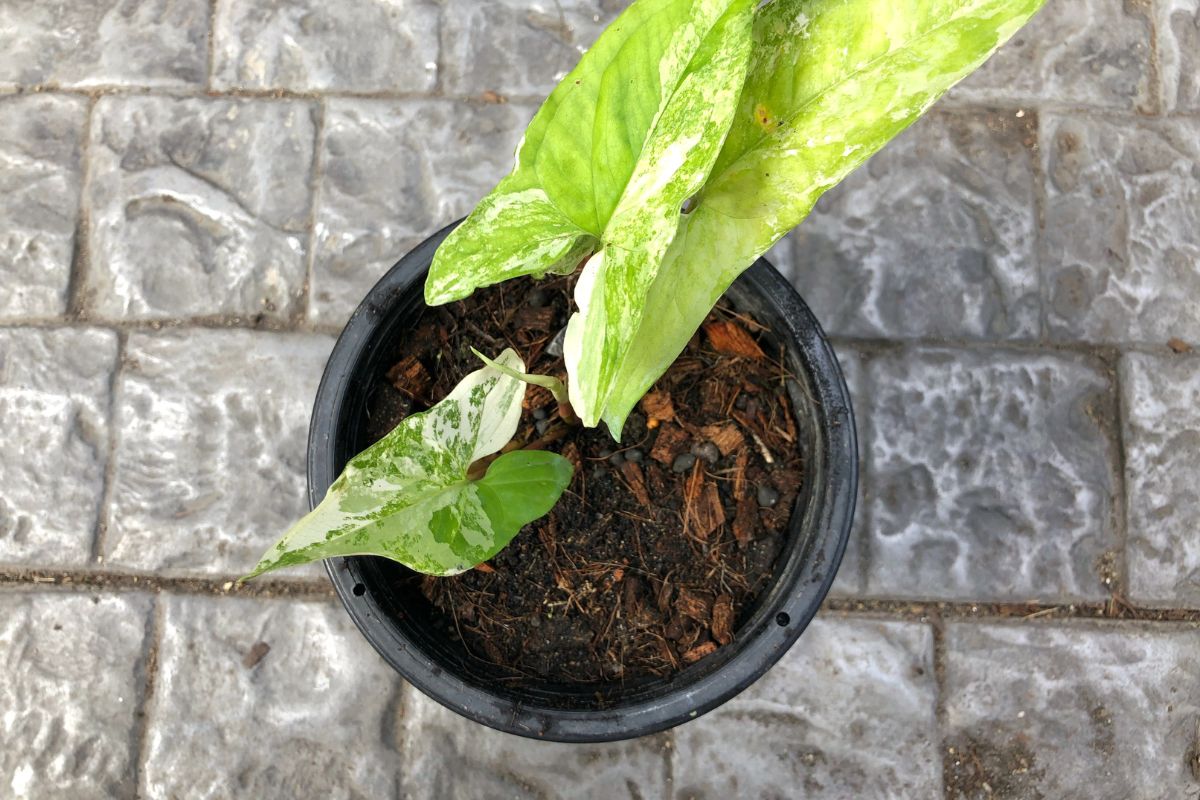
To keep your Arrowhead Plant healthy, you need the right soil and drainage. This plant loves a mix that helps it feel at home in the tropics. Here’s what works best:
- Peat Moss – It keeps the soil moist and full of nutrients.
- Perlite – This helps air move through the soil and stops it from getting too packed down or soggy.
- Pine Bark – It adds good stuff to the soil and helps with drainage.
Another great mix you can use is:
- 30% garden soil
- 25% coco peat
- 25% vermicompost
- 20% perlite
Make sure the soil’s pH is between 5.5 and 6.5. This slightly acidic level is perfect for the plant to take in nutrients. Since Arrowhead Vines can get root rot easily, good drainage is key. Use pots with holes at the bottom and put some small rocks or broken pots there first. This setup helps excess water drain, ensuring a healthy plant.
Arrowhead Plant Light Requirements
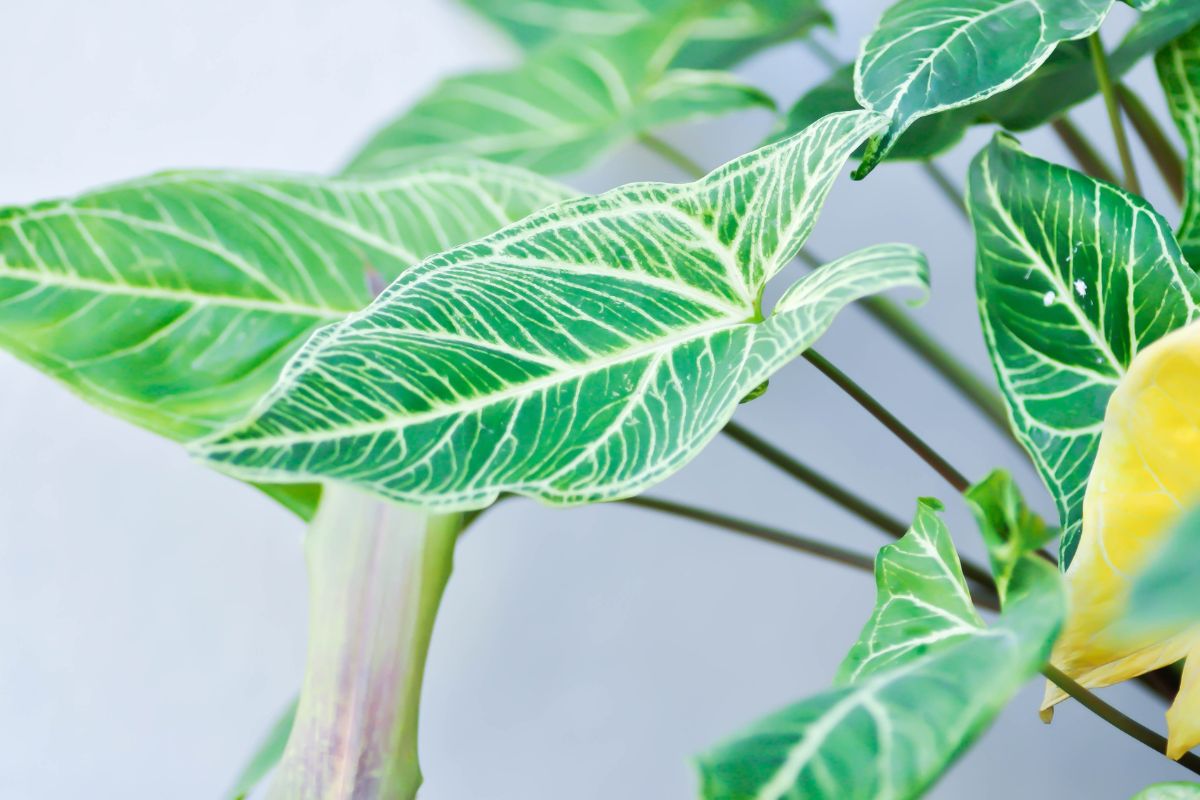
The ideal lighting for the Arrowhead Plant is bright, indirect sunlight. This mimics its natural habitat in tropical rainforests, where it receives filtered light.
While it prefers bright light, the Arrowhead Plant can adapt to lower light conditions. Insufficient light can lead to leggy growth, with elongated stems and smaller leaves.
Direct sunlight can be detrimental to the Arrowhead Plant, causing leaf burn and scorching. Avoid placing the plant in direct sun, especially during midday hours. Gentle morning sun or late afternoon light is more tolerable.
For indoor settings, place the plant near east or north-facing windows for ample bright light without harshness. If near a window with strong sunlight, use sheer curtains to create partial shade.
Signs of light stress include yellowing leaves or loss of variegation, indicating too much light. Leggy growth may signal the plant needs brighter light.
Arrowhead Plant Watering Requirements
The Arrowhead Plant prefers to dry out between waterings. It is recommended to water the plant when the top 2 to 3 inches of soil feel dry to the touch. Overwatering can lead to root rot, so ensure the soil is not soggy.
Typically, during the growing season (spring and summer months), the plant may require watering once a week. In the winter months, this can be reduced to every 10 to 14 days, depending on the indoor climate and humidity levels.
When watering, it’s best to thoroughly saturate the soil until water drains out of the bottom of the pot. This ensures that the entire root ball receives moisture. Discard any excess water that collects in the saucer to prevent the roots from sitting in water.
Arrowhead Plant Humidity Requirements
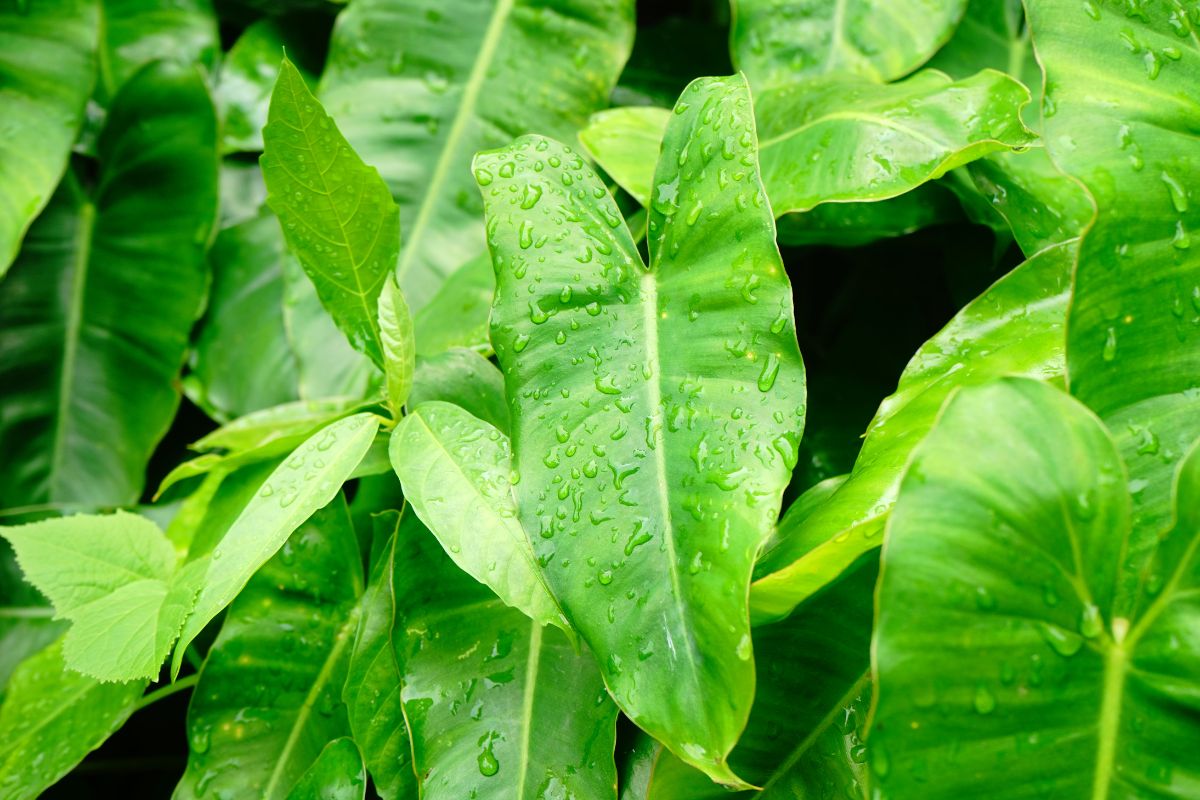
The Arrowhead Plant thrives in humid environments, ideally between 50% and 70%. This reflects its native tropical habitat, where humidity levels are consistently elevated.
To maintain adequate humidity, especially in drier indoor conditions, you can mist the plant regularly. Another method is to place its pot on a pebble tray filled with water, creating a microclimate around the plant to increase humidity levels.
If the humidity is too low, the plant may exhibit symptoms such as browning leaf tips or edges. Sufficient humidity is particularly important during the winter months when indoor heating can significantly reduce moisture levels in the air.
Arrowhead Plant Temperature Requirements
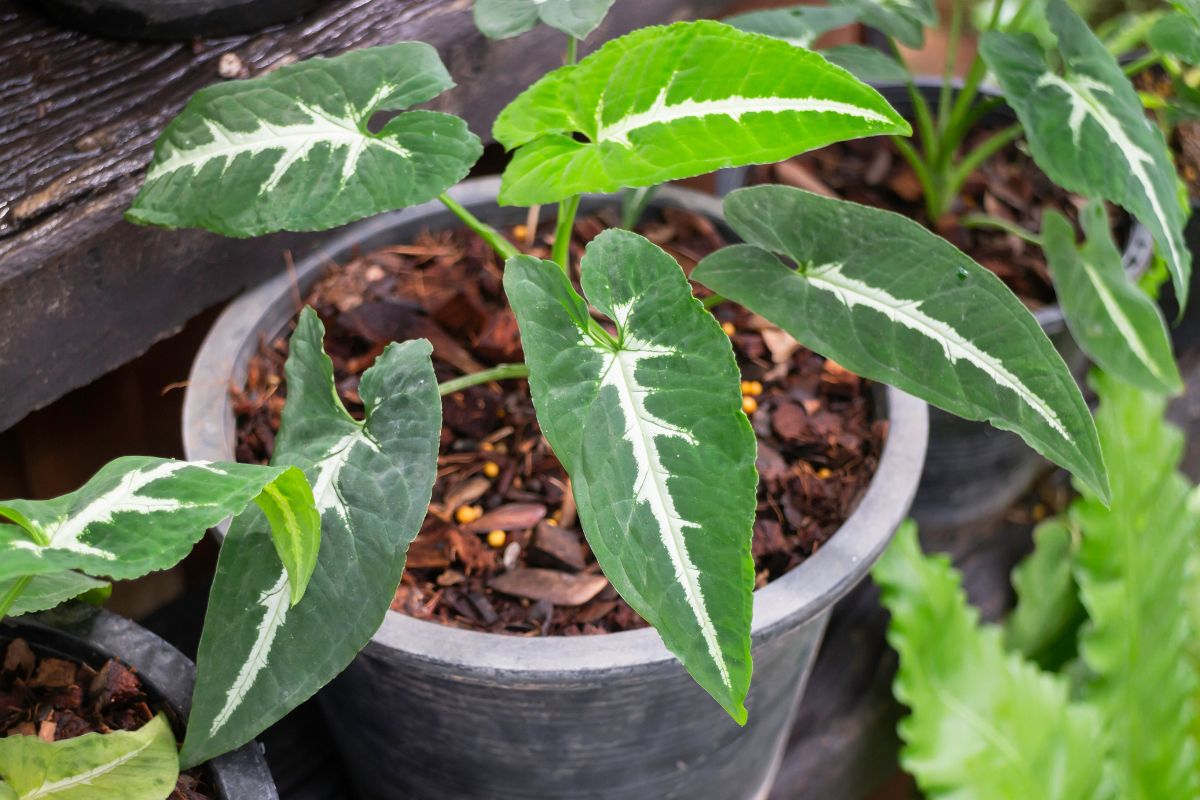
The ideal temperature for healthy growth of the Arrowhead Plant is around 70°F to 75°F (21°C to 24°C). This range supports the plant’s active growth phase, particularly during spring and summer.
The Arrowhead Plant can tolerate temperatures as low as 60°F (15°C). However, prolonged exposure to cooler temperatures can hinder its growth and lead to stress.
The plant is sensitive to extreme temperature fluctuations. It should be kept away from cold drafts, air conditioning vents, or heating sources, which can cause stress and damage.
While the Arrowhead Plant can handle warmer temperatures, it is essential to ensure that humidity levels remain adequate. High temperatures combined with low humidity can lead to dehydration.
Fertilizer for Arrowhead Plant
A balanced liquid fertilizer with an NPK ratio of 10-10-10 or 20-20-20 is ideal for the Arrowhead Plant. Dilute to half strength and apply monthly during the growing season to promote growth.
Granular slow-release fertilizers can be applied once in the spring and again in mid-summer. These ensure a steady nutrient supply over time without over-fertilization. Water-soluble houseplant fertilizers are also suitable and can be mixed with water for regular watering sessions.
- Fertilize once a month during the active growing season.
- Reduce or stop fertilization in the fall and winter when growth slows.
- Mix liquid fertilizers with water and apply during regular watering.
- Sprinkle granular types on the soil surface and lightly mix in.
If the plant appears sparse or leggy, it may need fertilization. Healthy Arrowhead Plants should have lush foliage. Avoid over-fertilization as it can cause leggy growth. Frequent, diluted feedings are better than heavy doses infrequently.
How to Prune the Arrowhead Plant
The best time to prune your Arrowhead Plant is during the growing season, specifically in spring or summer. Early fall can also be suitable in temperate climates.
Steps for pruning the Arrowhead Plant:
- Look for long, leggy stems, discolored leaves, or sparse areas. These indicate that pruning is needed.
- Use clean, sharp pruning shears or scissors. Disinfecting the tools beforehand is recommended.
- Trim back long, spindly stems to about 6-8 inches above the soil line. This encourages bushier growth and removes unsightly leggy sections.
- Pinch or cut the tips of other stems to promote branching and fullness. Remove 2-5 leaves from the ends of the stems.
- Clear out any yellow or unhealthy leaves to maintain the plant’s overall health and appearance.
After pruning, ensure the plant receives adequate light and water. Avoid overwatering, as this can lead to root rot, especially after pruning.
How to Repot the Arrowhead Plant
Repot your Arrowhead Plant when the roots have filled the current pot, typically every 1-2 years. Signs include roots growing out of the drainage holes or the plant becoming top-heavy.
How to Repot an Arrowhead Plant:
- Select a pot one size larger than the current one with drainage holes to prevent water accumulation.
- Use a rich, organic, fresh potting mix that drains well. A mix designed for African Violets is often suitable for Arrowhead Plants.
- Gently take the plant out of its current pot, being careful not to damage the roots. If the roots are tightly bound, gently loosen them before placing the plant in the new pot.
- Place a layer of fresh soil in the bottom of the new pot.
- Position the plant in the center and fill around the roots with more soil, ensuring the plant is at the same depth as it was in the previous pot.
- Water the plant thoroughly after repotting to help settle the soil around the roots.
Keep the newly repotted plant in a location with bright, indirect light. Monitor its watering needs closely for the first few weeks.
How to Propagate the Arrowhead Plant
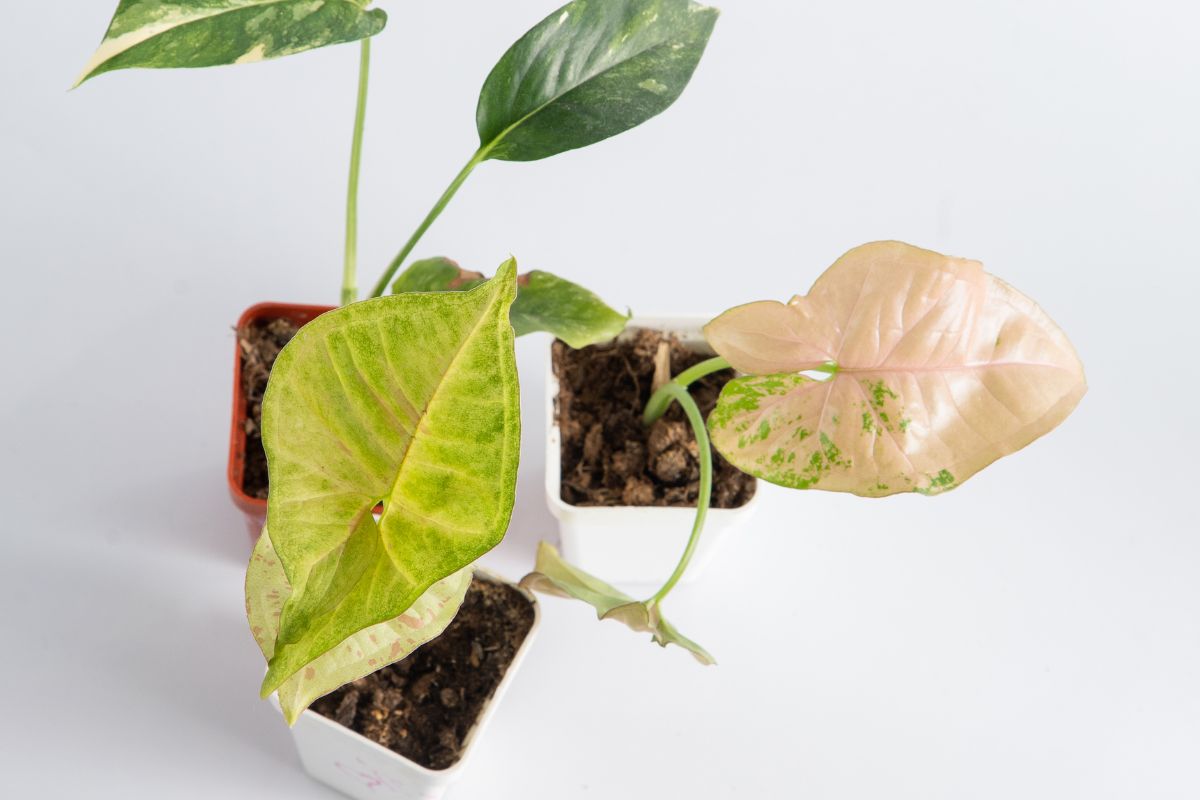
Propagating the Arrowhead Plant is straightforward and can be done using water or soil propagation. Here’s a guide on how to propagate your Arrowhead Plant successfully.
Arrowhead Plant Water Propagation:
- Choose a healthy stem and cut just below a growth node, ensuring it has at least 1-2 leaves and 2-3 nodes.
- Remove the bottom leaves to prevent decay in the water.
- Submerge the cut end and nodes in a glass of water, covering the nodes but not the leaves.
- Place in bright, indirect sunlight and change the water every 5-7 days to prevent algae growth.
- Roots will develop within a week or two. Once the roots are about an inch long, transplant the cutting into soil.
Arrowhead Plant Soil Propagation:
- Cut a healthy stem below a node and remove the lower leaves.
- Insert the stem cutting into a well-draining, moist potting mix, burying at least 2-3 nodes in the soil.
- Water the cutting lightly and keep the soil consistently moist but not soggy, watering every 4-5 days.
- Place the pot in bright, indirect light to encourage growth.
- Roots will form within a few weeks. Gently tug on the cutting to check for resistance, indicating root establishment.
Maintain a warm environment (65-75°F or 18-24°C) with humidity levels around 40-60%. Increase humidity by placing the pot on a tray of pebbles and water or using a humidifier.
For soil-propagated cuttings, water when the top inch of soil feels dry. For water-propagated cuttings, ensure they have fresh water weekly.
Always make sure that the plants receive bright, indirect sunlight to promote healthy growth. Avoid direct sunlight, which can scorch the delicate leaves.
Is the Arrowhead Plant Toxic?
All parts of the Arrowhead Plant are toxic to dogs and cats. The plant produces a poisonous sap that, while not lethal, can cause skin irritation and mouth burning if ingested.
Keep your Arrowhead Plant away from pets and humans. Symptoms to watch for include:
- Excessive drooling or salivation
- Loss of appetite
- Mouth irritation and pain
- Mouth sores
- Pawing at the mouth
- Difficulty swallowing
- Swollen lips, tongue, or mouth
- Vomiting
If you notice any of these symptoms and suspect your pet has ingested the plant, contact your veterinarian or local poison control center immediately.
Arrowhead Plant Pests, Diseases, and Problems
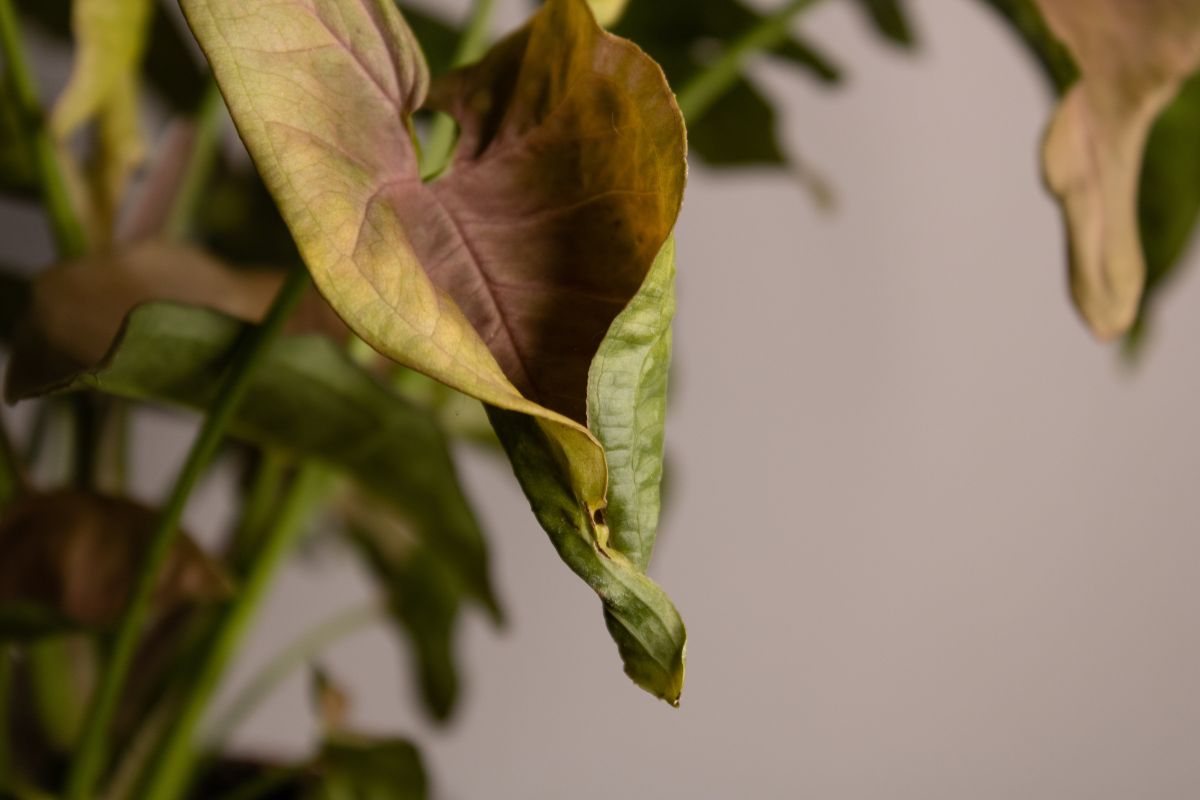
While the arrowhead is relatively resistant to pest infestations, if you have other plants, they may expose the arrowhead to spider mites, aphids, scale, or mealybugs.
Should you notice indications of any of these pests, treat your Arrowhead immediately with neem oil or organic insecticidal soap.
- Read more: Do Indoor Plants Attract Bugs?
An Arrowhead plant’s yellowing leaves may indicate overwatering or low light. However, yellowing older leaves at the base of the plant is normal. Low humidity can also contribute to yellow or brown foliage.
Drooping leaves may indicate underwatering. If the soil bed dries out completely because you have forgotten to water your plant, soak your plant in a sink.
Place approximately four inches of water in the sink and leave your Arrowhead to soak up water through its container’s drainage holes for about 45 minutes. When the water reaches the top two inches of the soil bed, drain the sink, and allow the plant to drain completely as well.
Growing Arrowhead Plant Final Thoughts
The arrowhead plant is a favorite among many, and it’s easy to see why. It’s simple to take care of and adds a vibrant touch of green to any space.
For those just starting out with gardening, the Arrowhead Plant is perfect. It offers something a bit different but doesn’t demand a lot of attention. It grows fast and needs just a little bit of care.
Arrowhead Plant FAQs
1. How Much Light Does an Arrowhead Plant Need?
The Arrowhead Plant needs 6-8 hours of bright, indirect light each day for optimal growing conditions. Direct sunlight should be avoided as it can burn the leaves.
2. When Should I Water My Arrowhead Plant?
Water your Arrowhead Plant when the soil surface feels dry to the touch. The top surface should feel moist but not overly wet. Avoid overwatering to prevent root rot. Ensure that your pot and soil are well-draining so excess water exits through the drainage holes.
3. How Do I Make My Arrowhead Plant Bushy?
Encourage business in your Arrowhead Plant by pruning off lower branches once they reach three feet tall. This promotes new growth along the main stem.
4. Do Arrowhead Plants Like Coffee Grounds?
Yes, coffee grounds can be beneficial for Arrowhead Plants when added to compost or mulch. Coffee grounds provide nutrients such as nitrogen, phosphorus, and potassium, which promote healthy leaf development and overall plant health.
5. Is the Arrowhead Plant Toxic to Humans?
Yes, the Arrowhead Plant is toxic to humans. Keep it away from children and adults to prevent ingestion. Seek medical attention immediately if ingestion occurs.
6. Are Arrowhead Plants Toxic to Dogs?
Yes, Arrowhead Plants are toxic to dogs and cats if ingested. Seek a veterinarian if you notice symptoms like vomiting, excessive drooling, difficulty swallowing, and swollen lips.
7. Why Is My Arrowhead Plant Turning Yellow?
If your Arrowhead Plant starts to turn yellow, it could mean several things:
- It’s getting too little sun.
- It’s been exposed to direct sunlight for too long.
- The soil isn’t draining properly, leading to overwatering.
- It was exposed to cold temperatures for too long.
- The humidity is too low.
For more houseplant care tips and guides, choose one of these:




